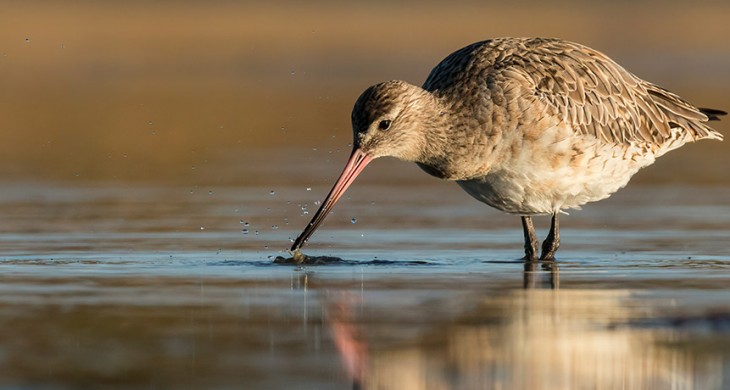17 March 2015
Kūaka/bar-tailed godwit
Christchurch photographer Steve Attwood takes a look at the migration patterns of the kūaka/bar-tailed godwit.
In autumn, when kūaka return to their breeding grounds in the Arctic tundra it can trigger one of the greatest natural spectacles regularly observed in Aotearoa New Zealand.
While they can arrive in dribs and drabs in our spring, the kūaka frequently leave for their northern breeding grounds en masse.
One kūaka, the tute or kahukura, takes to the air first to test it. If all is good, it calls the others and they rise in a funnel or spiral called the ‘poringi’ sometimes comprising of hundreds or even thousands of individual birds, filling the sky with their chatter and the sound of their wings as they wheel to orientate themselves before heading for Alaska via refuelling spots along the coast of China’s Yellow Sea.
Who has seen the nest of the kūaku?
Te Waihora/Lake Ellesmere is a regular feeding ground for kūaka, with several hundred birds visiting the lake each season. Some of the juveniles will choose to stay behind and over-winter here. But for the majority of ‘our’ godwits, the imperative of breeding sees them return to the Arctic Circle in Alaska.
For Maori, the kūaka was a bird of mystery for, in spite of it coming to Aotearoa New Zealand in numbers that can reach 100,000, it does not nest here, hence the whakatauki: Kua kite te kohanga kūaka? (Who has seen the nest of the kūaka?)
It was thought that they came from, or passed through, the ancestral home Hawaiiki and were believed to accompany the spirits of the departed. Kūaka on the wing are known as “waka kūaka”. During daylight the ancestors followed the course of the flight in their canoes. In the night the ancestors would listen for the cries of the kūaka above the fleet of canoes and so be guided by them.
Kūaka were an important source of food. When the birds were at their fattest at the point of their autumn departure, Māori would gather on high ridges near harbours and estuaries over which the departing birds would fly low. There they could be knocked from the sky with long poles.
They are the most numerous tundra-breeding shorebird species to occur in Aotearoa New Zealand. Birds generally begin arriving from early September after a non-stop eight or nine day flight. This is the longest flight across the ocean of any land bird and a considerable feat when you consider that, unlike a seabird, there is no chance of an inflight snack, or a rest on the surface of the water along the way.
For most of their time in New Zealand kūaka wear rather nondescript brownish plumage. But, toward autumn the males begin to take on their brick-red breeding colours and the contrast markings on their feathers become more prominent. Females are less colourful, but do become strongly streaked and barred on neck, breast and flanks, sometimes with a pale reddish wash. Usually silent on the ground, one of the early signs that a departure is imminent is a notable increase in both frequency and volume of calls.
Bar-tailed godwits are fully protected in New Zealand. Current data suggests the population is stable, although it is known to have declined at some sites. There is also international concern about the loss of their migratory refuelling spots on the Chinese coast, due largely to the drainage and land-fill of estuaries for industrial development.
Fact file:
- Kūaka – the bar-tailed godwit – Limosa lapponica
- New Zealand status: Native

